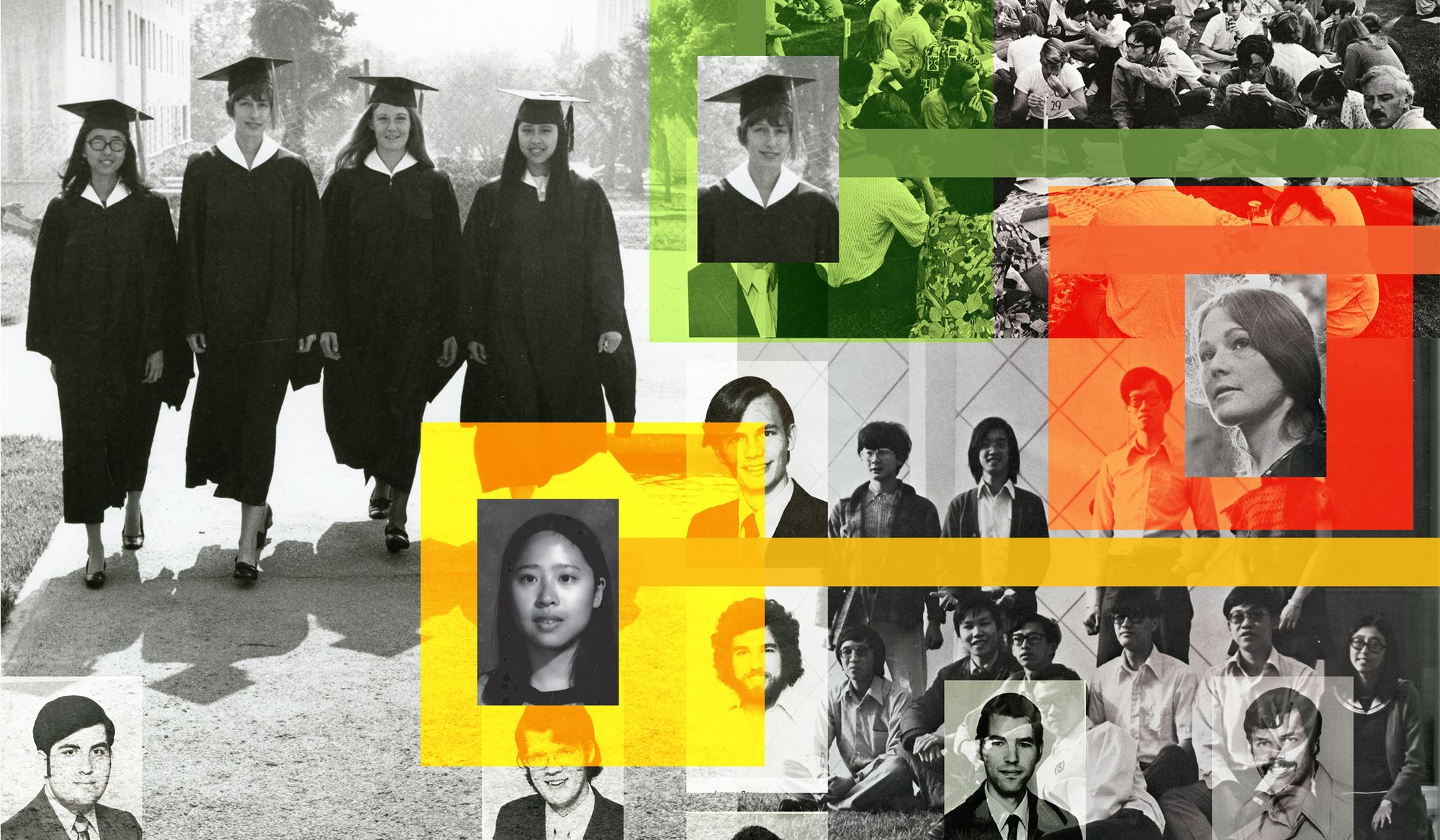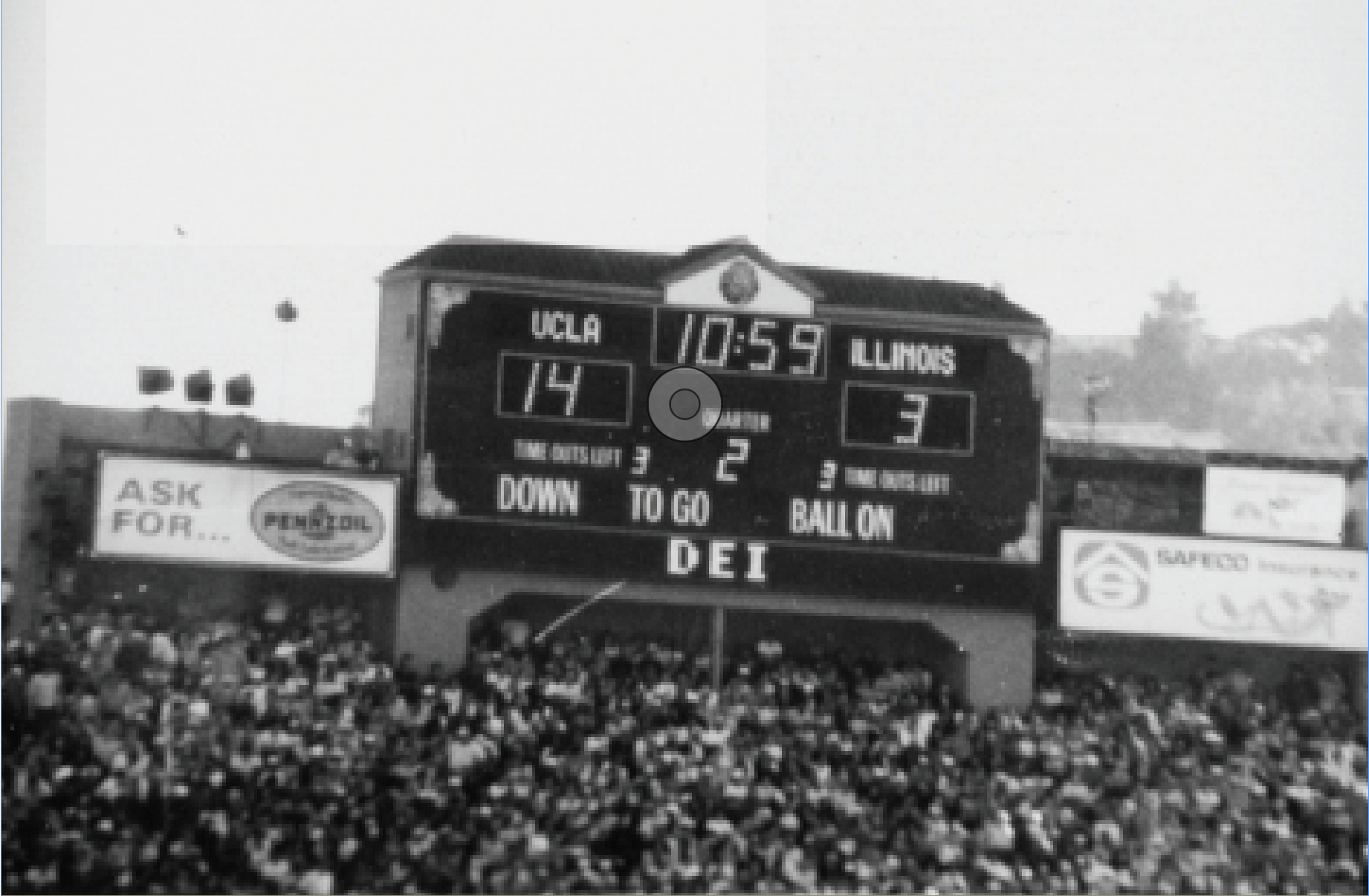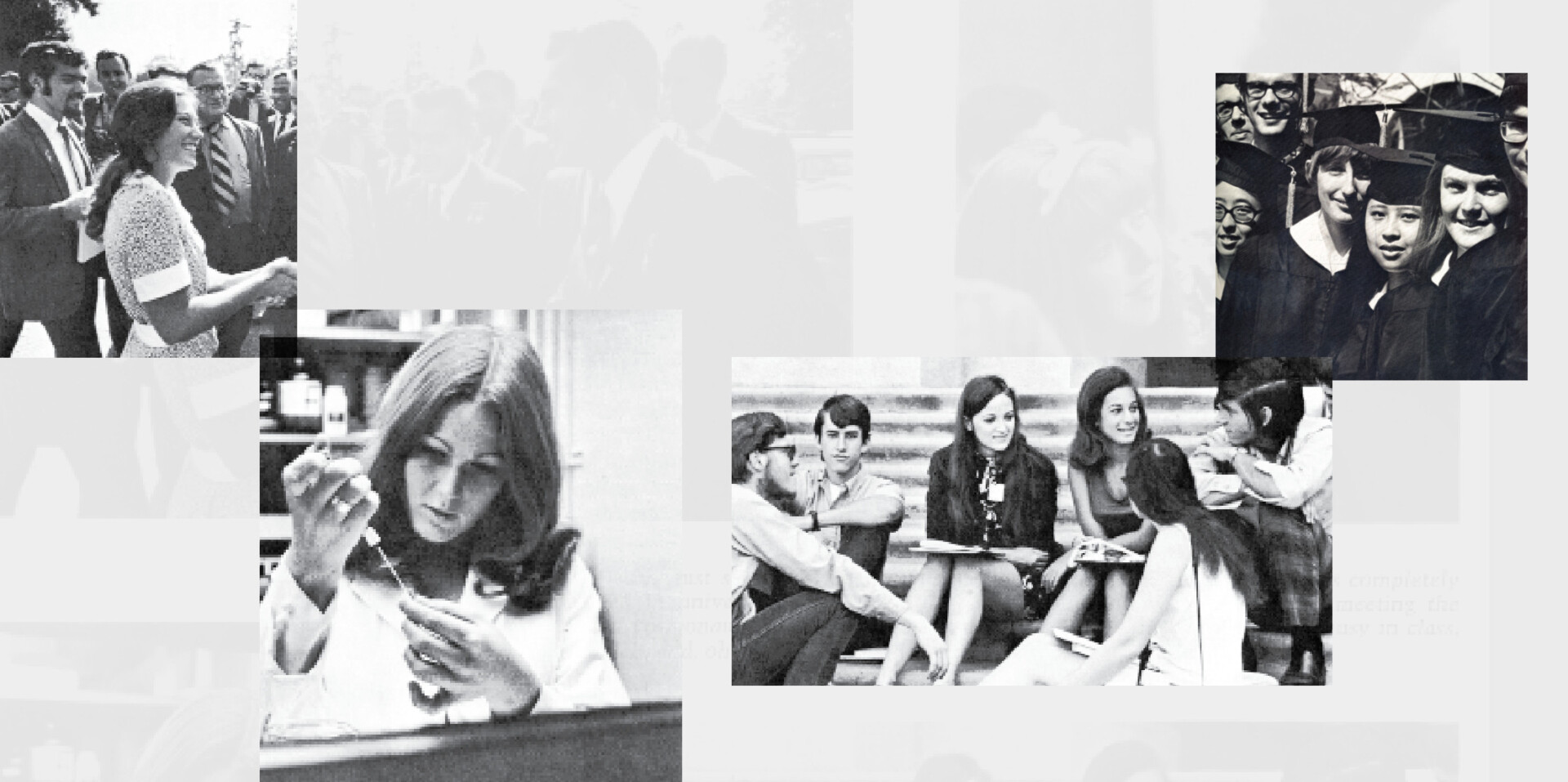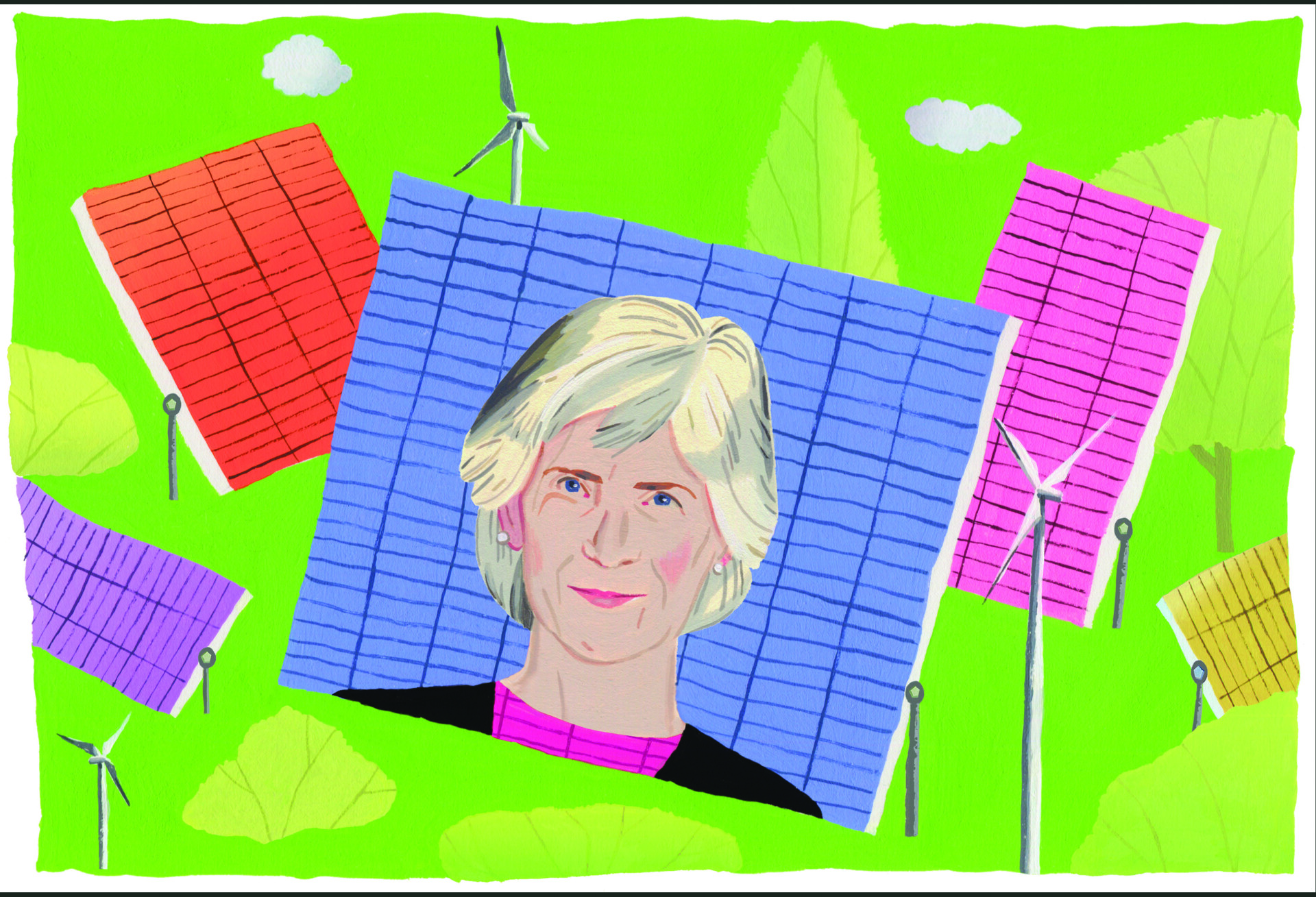Groundbreakers
On the 50th anniversary of their graduation, the first women to earn bachelor’s degrees at Caltech reflect on the experience
by Marisa Demers

On the 50th anniversary of their graduation, the first women to earn bachelor’s degrees at Caltech reflect on the experience.
For decades, some of the brightest minds at Caltech debated the merits of educating women at the Institute. Could they handle the rigor? Would they contribute to their fields or stay home and raise a family? Would coeducation become a failed experiment?
In spring 1973, four young women walked across the commencement stage prepared to make their mark on the world in science, engineering, at home, and anywhere else they wanted.”
Stephanie Charles, MS (BS ’73) graduated with honors. Future engineer. Sharon Long, PhD (BS ’73) graduated with honors. Future biochemist and professor. Deborah Chung, PhD (BS ’73, MS ’73) graduated with honors. Future engineer and professor. Flora Wu, MD (BS ’73) graduated with honors. Future physician.
All were transfer students and made history as the first women to earn undergraduate degrees from Caltech. On the 50th anniversary of their graduation, three of these alumnae, Charles, Chung, and Long spoke to Techer about their experience as Caltech pioneers. (Flora Wu could not be reached for an interview.)
“I was on the board of the Caltech Alumni Association for eight years and went to just about every graduation during that time. I remember thinking that I would have to count the number of women to verify if they were still a minority.”
— Stephanie Charles, MS (BS ’73)
ON DECIDING TO APPLY
CHUNG: I went to King’s College, which was one of the top secondary schools for math and science in Hong Kong. When I was accepted to Wellesley College, my parents and I were very proud. It is an excellent school but none of us knew what a liberal arts education meant! In my first year, I was already taking senior-level mathematics courses. I felt like there was not a whole lot left for me to learn. I went crying to my foreign student adviser, and she helped me transfer. I don’t remember how many schools I applied to, but Caltech was always top in my mind.
CHARLES: My dad was in the missile business and dealt with scientists and engineers, which were careers I was interested in. He was very influential in my life and suggested I focus on three schools: Caltech, MIT, and Harvey Mudd College. In 1969, we visited all three. Caltech was truly my first choice from the beginning, but they said they were not accepting women that year, and to try again next year. When they admitted me in 1970, it was a no-brainer that I would attend.
LONG: From the time I was in high school, I had already identified biochemistry as something I wanted to study. I liked Caltech because it offered a broad education in biology, chemistry, and biochemistry. The year I was a freshman, Caltech was not open to women, and I went to Harvey Mudd College instead. At that time, it was just a fact of life that there were both all-men’s and all-women’s institutions. I did not think of my situation through a larger lens of what it said about society.
ON BEING THE ONLY ONE IN CLASS
CHUNG: My high school was actually a boys’ school that accepted some girls in the later grades, so I was used to that environment. Obviously, I am all for women getting opportunities, but at that time, I just wanted to learn and do my best. I transferred to Caltech in 1971 and earned my bachelor’s and master’s in two years. My focus was on my studies.
The students at Caltech were pretty open, and I do not remember the boys saying anything negative to me. I am sure I would have ignored them if they did. Whatever other people might have thought of me was their problem, not mine.
I lived in Lloyd House. [Female-only corridors were established in some of the houses.] They did some crazy things like throw mud at each other. That craziness was a bit too much for me but it helped us all become a closely-knit group. My experience in the house was like brothers and sisters hanging together, doing crazy things and studying together.
CHARLES: In 1970, Sharon and I were the only female sophomores. In most of my physics classes, I was the only woman. I never had anyone be negative to me. Yes, women were a tiny minority at the time, but we were getting good grades.
If I were inclined to be sensitive, the one thing that could have been taken negatively was when a physics teaching assistant got drunk and expressed relief that the “distraction” of having women on campus had not dragged down the guys’ grades. But I laughed it off because it was a skeptical comment about the men, not the women.
LONG: Being such a tiny minority at Caltech was informative because whatever metric you picked—How smart are you? How tall are you? How ambitious are you? How insecure are you?—I was in the middle of the distribution. There were men who were smart and not as smart. There were men who were confident and shouldn’t have been, and men who were not confident and should have been. It helped me see that the traits of being smart, ambitious, or insecure have nothing to do with your sex or gender. Because of that experience at Caltech, I didn’t feel intimidated or out of place in later education and work situations.
“For many of the professors, this was the first time they had women in the classroom. It was important for everyone to see that we behaved like any other student.”
— Deborah Chung, PhD (BS ’73, MS ’73)
“When female undergraduates arrived on campus, there were already women who had more senior roles, such as grad students and teaching assistants. It gave me a sense of continuity in the scientific community.”
— Sharon Long, PhD (BS ’73)
ON SETTING THE TONE
CHUNG: Going co-ed was a new experience for both teachers and students. For many of the professors, this was the first time they had women in the classroom. It was important for everyone to see that we behaved like any other student.
CHARLES: I was very rarely treated differently from other students. Only one instance comes to mind. In my first year, I took karate from Tsutomu Ohshima, who was the man that brought shotokan karate to Israel, France, and the United States. [He also founded the Caltech Karate Club in 1957.] He was just an extraordinary man, but I don’t think he ever taught women before. There were maybe three or four other women who were in the class with me.
One time early on, he had told everyone to do knuckle pushups, and I remember him looking at us girls. He waited for some time and said, “OK, girls can do pushups on their palms.” Karate is just as much about developing the mind as it is about developing strength, so all of us said no. He never again tried to separate us.
LONG: When female undergraduates arrived on campus, there were already women who had more senior roles, such as grad students and teaching assistants. It gave me a sense of continuity in the scientific community. I remember the Caltech Y organized some talks by women who were outstanding established scientists, including Dr. Chien-Shiung Wu [a physicist who worked on the Manhattan Project], and that was a great gift. It was helpful to see women who really loved science and who stuck with it.
ON GRADUATING
CHUNG: Graduation was the first time that Caltech really took notice of this moment. They photographed Sharon, Stephanie, Flora, and me in our caps and gowns, and I remember it being on the cover of E&S magazine [now Caltech Magazine]. I think we made the local newspaper, too. But before then, I never had a feeling of being different, which was good, actually. But at graduation, I realized that, wow, this is different.
CHARLES: I remember [Nobel laureate and Caltech professor Richard] Feynman walking up to me and saying “You’re the first,” which was related to the fact that Charles comes earlier in the alphabet than Chung or Long or Wu. The professor who handed me my diploma on stage made that comment, too. A great deal has been made of my being the first. I have an assortment of friends who will loudly announce this at gatherings. I do not make a big deal out of it, but it’s amusing since it has more to do with alphabetical order and Caltech being slow to admit women than with anything I actually did.
I was on the board of the Caltech Alumni Association for eight years and went to just about every graduation during that time. I remember thinking that I would have to count the number of women to verify if they were still a minority. Now everyone expects to see a lot of women on campus, and that is a welcome change.

EPILOGUE
After graduation, Charles moved to Northern California to earn a master’s in electrical engineering at Stanford University. She remained in Silicon Valley and worked as an engineer in the telecommunications industry for nearly 30 years. Since retiring, Charles has been an American Red Cross volunteer leader, who ensures that people displaced by fires, floods, or other natural disasters have access to shelter and food.
Chung also attended graduate school. She received a doctorate in materials science at MIT, and has been a professor of mechanical and aerospace engineering at the University at Buffalo, The State University of New York, since 1986. Recognized as a leading scientist in her field, Chung is ranked 10th among all living materials researchers in the world, according to a 2022 study based on publications and citations. She also created smart concrete, which contains carbon fiber that renders with self-sensing abilities to the concrete. With Chung’s invention, engineers using an electrical probe can detect stresses, deformations, or damage in concrete before they become visible.
After forgoing medical school, Long took a gap year and later earned her doctorate in cell and development biology from Yale University. Currently a professor at Stanford University, the 1992 MacArthur Fellow seeks to understand how symbiotic bacteria interact with their plant hosts. Her work established that bacteria and plants recognize and control each other by exchange of chemical signals. She is an elected member of the National Academy of Sciences and has received other recognitions.

Marisa Demers is a freelance writer who got her start covering wildfires and breaking news for newspapers. She also worked for Caltech and was most recently an assistant director for the Caltech Associates. A San Gabriel Valley native, she has enjoyed following Caltech’s scientific breakthroughs and student pranks over the years. You can read more of her writing on widestletter.com and follow her on Twitter at @WidestLetter.
Related Articles
-

A Legendary Hack Turns 40
In this moment of Caltech mischief that required months of planning, students Ted Williams, PhD (BS ’84) and Dan Kegel (BS ’86) manipulated the sco...
-

The Pioneers
On the 50th anniversary of their graduation, the first four-year female graduates reflect on their time on campus—and where they went from here.
-

All In
The key to a more sustainable future? Make sure everyone can join the hunt for solutions, says National Energy Technology Laboratory director Maria...